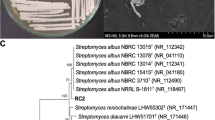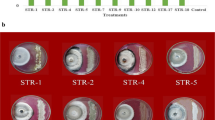Abstract
Plant-associated actinobacteria are rich sources of bioactive compounds including indole-derived molecules such as phytohormone indole-3-acetic acid (IAA). In view of few investigations concerning the biosynthesis of IAA by endophytic actinobacteria, this study evaluated the potential of IAA production in endophytic streptomycete isolates sourced from medicinal plant species Taxus chinensis and Artemisia annua. By HPLC analysis of IAA combined with molecular screening approach of iaaM, a genetic determinant of streptomycete IAA synthesis via indole-3-acetamide (IAM), our data showed the putative operation of IAM-mediated IAA biosynthesis in Streptomyces sp. En-1 endophytic to Taxus chinensis. Furthermore, using the co-cultivation system of model plant Arabidopsis thaliana and streptomycete, En-1 was found to be colonized intercellularly in the tissues of Arabidopsis, an alternative host, and the effects of endophytic En-1 inoculation on the model plant were also assayed. The phytostimulatory effects of En-1 inoculation suggest that IAA-producing Streptomyces sp. En-1 of endophytic origin could be a promising candidate for utilization in growth improvement of plants of economic and agricultural value.





Similar content being viewed by others
References
Patten CL, Glick BR (2002) Role of Pseudomonas putida indole-acetic acid in development of the host plant root system. Appl Environ Microbiol 68:3795–3801
El-Deeb B, Bazaid S, Gherbawy Y, Elhariry H (2012) Characterization of endophytic bacteria associated with rose plant (Rosa damascena trigintipeta) during flowering stage and their plant growth promoting traits. J Plant Interact 3:248–253
Pereira GVDM, Magalhães KT, Lorenzetii ER, Souza TP, Schwan RF (2012) A multiphasic approach for the identification of endophytic bacterial in strawberry fruit and their potential for plant growth promotion. Microb Ecol 63:405–417
Verma VC, Singh SK, Prakash S (2011) Bio-control and plant growth promotion potential of siderophore producing endophytic Streptomyces from Azadirachta indica A. Juss. J Basic Microbiol 51:550–556
Kim YC, Leveau J, Gardener BBM, Pierson EA, Pierson LS, Ryu C-M (2011) The multifactorial basis for plant health promotion by plant-associated bacteria. Appl Environ Microbiol 77:1548–1555
Kang BR, Yang KY, Cho BH, Han TH, Kim IS, Lee MC, Anderson AJ, Kim YC (2006) Production of indole-3-acetic acid in the plant-beneficial strain Pseudomonas chlororaphis O6 is negatively regulated by the global sensor kinase. GacS Curr Microbiol 52:473–475
Sekine M, Ichikawa T, Kuga N, Kobayashi M, Sakurai A, Syono K (1988) Detection of the IAA biosynthetic pathway from tryptophan via indole-3-acetamide in Bradyrhizobium spp. Plant Cell Physiol 29:867–874
Malhotra M, Srivastava S (2006) Targeted engineering of Azospirillum brasilense SM with indole acetamide pathway for indole acetic acid over-expression. Can J Microbiol 52:1078–1084
Furukawa T, Koga J, Adachi T, Kishi K, Syono K (1996) Efficient conversion of l-tryptophan to indole-3-acetic acid and/or tryptophol by some species of Rhizoctonia. Plant Cell Physiol 37:899–905
Robinson M, Riov J, Sharon A (1998) Indole-3-acetic acid biosynthesis in Colletotrichum gloeosporioides f. sp. aeschynomene. Appl Environ Microbiol 64:5030–5032
Prusty R, Hunter A, Kashpur O, Normanly J (2010) Aberrant synthesis of indole-3-acetic acid in Saccharomyces cerevisiae triggers morphogenic transition, a virulence trait of pathogenic fungi. Genetics 185:211–220
Legault GS, Lerat S, Nicolas P, Beaulieu C (2011) Tryptophan regulates thaxtomin A and indole-3-acetic acid production in Streptomyces scabiei and modifies its interactions with radish seedlings. Phytopathology 101:1045–1051
Manulis S, Shafrir H, Epstein E, Lichter A, Barash I (1994) Biosynthesis of indole-3-acetic acid via the indole-3-acetamide pathway in Streptomyces spp. Microbiology 140:1045–1050
Narayana KJ, Peddikotla P, Krishna PSJ, Venketeswarlu Y, Vijayalakshmi M (2009) Indole-3-acetic acid production by Streptomyces albidoflavus. J Biol Res THESSALONIKI 11:49–55
Somers E, Ptacek D, Gysegom P, Srinivasan M, Vanderley-den J (2005) Azospirillum brasilense produces the auxin-like phenylacetic acid by using the key enzyme for indole-3-acetic acid biosynthesis. Appl Environ Microbiol 71:1803–1810
Spaepen S, Vanderleyden J, Remans R (2007) Indole-3-acetic acid in microbial and microorganism -plant signaling. FEMS Microbiol Rev 31:425–448
Lin L, Tan RX (2011) Cross-kingdom actions of phytohormones: a functional scaffold exploration. Chem Rev 111:2734–2760
Spaepen S, Vanderleyden J (2011) Auxin and plant-microbe interactions. Cold Spring Harb Perspect Biol 3:a001438
Arnold AE, Mejía LC, Kyllo D, Rojas EI, Maynard Z, Robbins N, Herre EA (2003) Fungal endophytes limit pathogen damage in a tropical tree. Proc Natl Acad Sci USA 100:15649–15654
Tan RX, Zou WX (2001) Endophytes: a rich source of functional metabolites. Nat Prod Rep 18:448–459
Thomas P, Soly TA (2009) Endophytic bacteria associated with growing shoot tips of banana (Musa sp.) cv. Grand Naine and the affinity of endophytes to the host. Microb Ecol 58:952–964
Lee S, Flores-Encarnacion M, Contreras-Zentella M, Garcia-Flores L, Escamilla JE, Kennedy C (2004) Indole-3-acetic acid biosynthesis is deficient in Gluconacetobacter diazotrophicus strains with mutations in cytochrome C biogenesis genes. J Bacteriol 186:5384–5391
Ryan RP, Germaine K, Franks A, Ryan DJ, Dowling DN (2008) Bacterial endophytes: recent developments and applications. FEMS Microbiol Lett 278:1–9
Ping L, Boland W (2004) Signals from the underground: bacterial volatiles promote growth in Arabidopsis. Trends Plant Sci 9:263–266
Sturz AV, Christie BR, Nowak J (2000) Bacterial endophytes: potential role in developing sustainable systems of crop production. Crit Rev Plant Sci 19:1–30
Lin L, Ge HM, Yan T, Qin YH, Tan RX (2012) Thaxtomin A-deficient endophytic Streptomyces sp. enhances plant disease resistance to pathogenic Streptomyces scabies. Planta 236:1849–1861
Conn VM, Walker AR, Franco CMM (2008) Endophytic actinobacteria induce defense pathways in Arabidopsis thaliana. Mol Plant Microbe Interact 21:208–218
Gutierrez RMP, Gonzalez AMN, Ramirez AM (2012) Compounds derived from endophytes: a review of phytochemistry and pharmacology. Curr Med Chem 19:2992–3030
Theunis M, Kobayashi H, Broughton WJ, Prinsen E (2004) Flavonoids, NodD1, NodD2, and nod-box NB15 modulate expression of the y4wEFG locus that is required for indole-3-acetic acid synthesis in Rhizobium sp. strain NGR234. Mol Plant Microbe Interact 17:1153–1161
Sarwar M, Kremer RJ (1995) Determination of bacterially derived auxins by a microplate method. Lett Appl Microbiol 20:282–285
Dubeau M-P, Poulin-Laprade D, Ghinet MG, Brzezinski R (2011) Properties of CsnR, the transcriptional repressor of the chitosanase gene, csnA, of Streptomyces lividans. J Bacteriol 193:2441–2450
Costacurta A, Vanderleyden J (1995) Synthesis of phytohormones by plant-associated bacteria. Crit Rev Microbiol 21:1–18
Idris EE, Iglesias DJ, Talon M, Borriss R (2007) Tryptophan-dependent production of indole-3-acetic acid (IAA) affects level of plant growth promotion by Bacillus myloliquefaciens FZB42. Mol Plant Microbe Interact 20:619–626
Comai L, Kosuge T (1980) Involvement of plasmid deoxyribonucleic acid in indole acetic acid synthesis in Pseudomonas savastanoi. J Bacteriol 143:950–957
Kamilova F, Kravchenko LV, Shaposhnikov AI, Azarova T, Makarova N, Lugtenberg B (2006) Organic acids, sugars, and l-tryptophane in exudates of vegetables growing on stonewool and their effects on activities of rhizosphere bacteria. Mol Plant Microbe Interact 19:250–256
Cao L, Qiu Z, You J, Tan H, Zhou S (2004) Isolation and characterization of endophytic Streptomyces strains from surface-sterilized tomato (Lycopersicon esculentum) roots. Lett Appl Microbiol 39:425–430
Shimizu M, Yazawa S, Ushijima Y (2009) A promising strain of endophytic Streptomyces sp. for biological control of cucumber anthracnose. J Gen Plant Pathol 75:27–36
Carol AB, Ma C, Moore E et al (2009) Multiple, novel biologically active endophytic actinomycetes isolated from upper Amazonian rainforests. Microb Ecol 58:374–383
Author information
Authors and Affiliations
Corresponding author
Electronic Supplementary Material
Below is the link to the electronic supplementary material.
284_2013_348_MOESM1_ESM.pdf
Fig. S1 Comparison of growth of Arabidopsis thaliana seedlings treated with endophytic En-1 inoculants and those with IFB-A02 and -A03 inoculants. Representatives of seedling growth 20 days post-treatment were shown in (b) En-1, (c) IFB-A02 and (d) IFB-A03 inoculation as compared to un-inoculated control (a). Scale: 2 cm (PDF 23 kb)
Rights and permissions
About this article
Cite this article
Lin, L., Xu, X. Indole-3-Acetic Acid Production by Endophytic Streptomyces sp. En-1 Isolated from Medicinal Plants. Curr Microbiol 67, 209–217 (2013). https://doi.org/10.1007/s00284-013-0348-z
Received:
Accepted:
Published:
Issue Date:
DOI: https://doi.org/10.1007/s00284-013-0348-z




